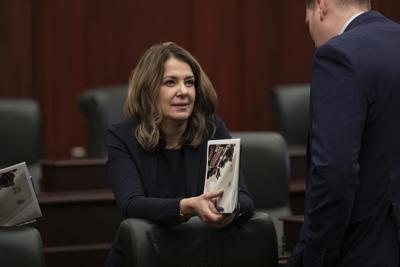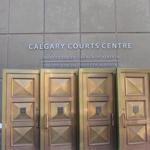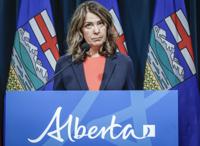EDMONTON - Premier Danielle Smith’s caucus worked into the wee hours of Tuesday morning to curtail debate and speedily pass a bill using the Charter’s notwithstanding clause to order 51,000 striking teachers back to work.
Smith’s United Conservatives, using their majority in the legislature and passing procedural rules to put one-hour limits on discussion, voted and passed the bill through three debate stages in six and a half hours, finishing at 2 a.m.
During debate, Education Minister Demetrios Nicolaides told the house the government faced an “undeniable moral imperative” to stop a three-week strike that was harming students’ social and educational development.
“This strike has moved beyond the state of inconvenience,” Nicolaides said.
Smith was not in the house for the introduction or the passage of the bill, having left earlier Monday evening on a trade mission to Saudi Arabia and other destinations in the Middle East.
The Opposition NDP voted against the bill, calling the use of the notwithstanding clause an authoritarian abuse of power from a government that professes to honour freedom and liberty.
Students are slated to be back in classes Wednesday.
The move puts Smith’s government on a potential collision course with more than 350,000 workers in other provincial unions, which promised an “unprecedented response" if the government invoked the clause to override teachers’ constitutional rights to assemble.
Some teachers and supporters were in the legislature chamber gallery and there were shouts of "Shame!" as Finance Minister Nate Horner formally introduced the bill late Monday afternoon.
There were more shouts of "Shame" after the bill passed Tuesday morning.
Before the bill was introduced, Smith told reporters the size of the strike and the need for ongoing labour stability in schools required the clause, which overrides Charter rights for up to five years.
“This is a very unique situation we find ourselves in. This is a unique strike. We’ve never had 51,000 workers off the job at the same time,” Smith said.
"I do not think people should indicate any broader type of approach (using the notwithstanding clause) when it comes to labour action.”
The strike has already affected the more than 740,000 students out of schools since it began Oct. 6.Â
Jason Schilling, head of the Alberta Teachers’ Association, said the union's executive council will meet soon to determine next steps, but said the use of the notwithstanding clause is a black mark and a disturbing precedent.
"This is a sad day for teachers. This is a sad day for Albertans to have a government that is willing to trample on your Charter rights for their own purposes," Schilling told reporters.
"They should be ashamed of themselves, and they're not," he said. "They will use it again on others."
Under the bill, the Alberta Teachers’ Association and its members would face hefty fines if they don’t comply: up to $500 a day for individuals and $500,000 a day for the union.
It would also impose a collective bargaining agreement previously put forward by the union and the province, which rank-and-file teachers overwhelmingly rejected in a vote. Teachers would receive a 12 per cent wage hike over four years, with a promise to hire 3,000 more teachers and 1,500 more educational assistants.
The bill also overrides protections in the Alberta Bill of Rights and the Alberta Human Rights Act.
The teachers from public, separate and francophone schools walked off the job after the two sides failed to find common ground, mainly on the issue of class sizes and complexity. The union called for immediate action on overcrowded classrooms and a lack of supports for students who need specialized care.
Smith has said the issues can't be solved with a one-size-fits-all approach at the bargaining table, but require a flexible, collaborative approach.
On Monday, she said the legislation wouldn't address all concerns. She committed to collecting and publicly reporting data on classroom sizes – a measure abandoned by the United Conservatives under former premier Jason Kenney – and to forming a special panel on classroom complexity.
However, the premier called the idea of a class size cap "arbitrary," arguing it has failed in the past.Â
Larger labour unrest may be on the horizon.Â
Late last week, Common Front, a coalition of 30 Alberta unions representing 350,000 workers, issued a statement promising an “unprecedented response” if the notwithstanding clause was invoked.
The group said using the clause is an abuse of process and effectively undermines the leverage unions have in negotiations.
Gil McGowan, president of the Alberta Federation of Labour and the point person for the Common Front, told reporters they are looking at all options, including a strike.
He said they will be meeting Tuesday with affiliated unions and others to finalize a plan they will announce Wednesday.
“If the government puts a gun to the head of the teachers, and they're not able to continue their strike, then we in the broader labour movement will stand where they're not able to,” he said.
There's political precedent for using the notwithstanding clause in an attempt to end labour action.
In 2022, Ontario Premier Doug Ford’s government used it to prevent a court challenge to a bill stopping 55,000 school support workers from going on strike.
They walked off the job on the day the legislation went into effect, shutting down thousands of schools. But public outcry prompted the province to repeal it.
This report by şĂÉ«tvwas first published Oct. 27, 2025.














































